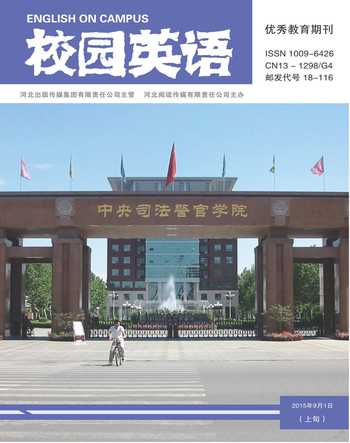Translation of Thunderstorm from the perspective of Skopostheorie
2015-05-30谢怡
谢怡
【Abstract】This thesis is aimed at studying Wang Zuoliang and Barness translation of Thunderstorm and find out how they apply objective rule,coherence rule and loyalty rule in the translation of drama.
【Key words】Thunderstorm; drama translation; Skopostheorie
This literary masterpiece is worthwhile to study and should be introduced to other culture abroad.Wang Zuoliang and Barnes translated Thunderstorm into English,which is widespread because of its excellent quality.
1.The Analysis of Thunderstorm Based on Skopos Rule
During translating the Thunderstorm,Wang Zuoliang typically wields the Skopos Rule.Wangs expected purpose of translation is to grasp the original spirit of author and then drama characters reappear vividly.
Example 1
鲁侍萍:哦,凤儿,我的可怜孩子。贵:说呀,这不是大姑娘上轿,说呀? (p83) LU:Well,Ill be-- what are you crying for? MA:Oh,Feng! LU:Well,come on.Its not as if you were swearing your life away! Whos it to be? (p94)
In China,there is a widespread two-part allegorical saying that “大姑娘上轿—头一回。”Wang translated it into “swearing your life away” which means this decision is not hard to make and has little effect on your life..
2.The Analysis of Thunderstorm Based on Coherence Rule
Coherence rule,also known as intra-textual rule,requires that the target text must conform to the coherent standards.
Example 1 鲁侍萍 (大哭起来)哦,这真是一群强盗!(走至萍面前,抽咽)你是萍,——凭,——凭什么打我的儿子? 周 萍 你是谁? MA:(breaking down) You are hooligans,too! (Going across to Chou Ping.) Youre my— mighty free with your fist! What right have you to hit my son?
PING:W ho are you? (p79)
Looking at her son,she cannot help but speak out his nickname “萍”。However,she suddenly came to realize the truth and immediately change the word “萍” into “凭”。The two characters are the kind of word called "homophone".Even thought Wang didnt adopt the word-for-word translation,he still keeps the language feature of Cao by using homophonic words-- my and might.
3.Conclusion
When study Wangs translation of Thunderstorm,we may find that he successfully grasps the innovative spirit of the original text and recreates the characters in the drama vividly.
References:
[1]Edwin Gentzier,Contemporary translation theories,Shanghai foreign language education press,2004.
[2]E.Nida:Language,Culture And Translating,Shang Foreign Language Education Press.1993.
[3]Halliday,M.A.K.And Hasan,On Translation,Shanghai:Foreign Translation Publishing House of China,1984.
[4]曹禺.曹禺代表作(上、下)[M].北京:华夏出版社,2008.
[5]曹禺.王佐良、巴恩斯译[M].北京:外文出版社,1958.
[6]郭建中.翻译中的文化因素:“异化和归化”[J].外国语,1998.
